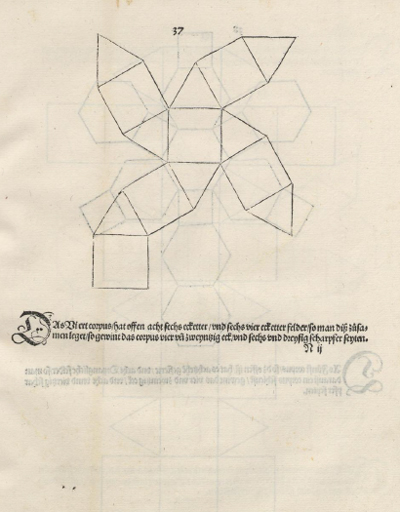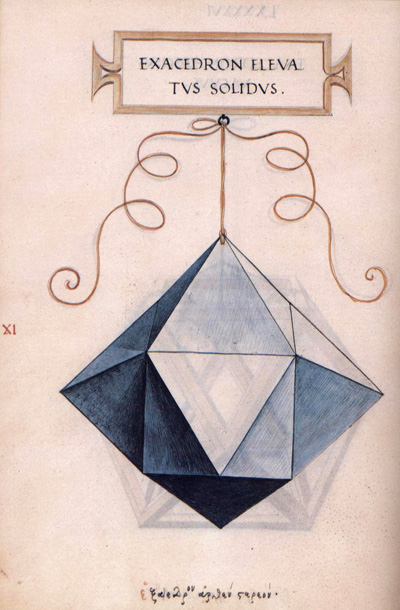- About MAA
- Membership
- MAA Publications
- Periodicals
- Blogs
- MAA Book Series
- MAA Press (an imprint of the AMS)
- MAA Notes
- MAA Reviews
- Mathematical Communication
- Information for Libraries
- Author Resources
- Advertise with MAA
- Meetings
- Competitions
- Programs
- Communities
- MAA Sections
- SIGMAA
- MAA Connect
- Students
- MAA Awards
- Awards Booklets
- Writing Awards
- Teaching Awards
- Service Awards
- Research Awards
- Lecture Awards
- Putnam Competition Individual and Team Winners
- D. E. Shaw Group AMC 8 Awards & Certificates
- Maryam Mirzakhani AMC 10 A Awards & Certificates
- Two Sigma AMC 10 B Awards & Certificates
- Jane Street AMC 12 A Awards & Certificates
- Akamai AMC 12 B Awards & Certificates
- High School Teachers
- News
You are here
Kepler and the Rhombic Dodecahedron: Renaissance Artists – They Almost Got It!
To set the stage for our presentation of a third view of the rhombic dodecahedron that Kepler taught us, this is a good opportunity to look at why Renaissance artists were interested in polyhedra and how they almost discovered the rhombic dodecahedron as a result of that interest.
During the Renaissance, sound translations of the classics were widely available. Artists, scientists and craftsmen were interested in mathematics and, in particular, in polyhedra. They found them to be beautiful objects for depiction in their artwork as well as good examples for the practice of the new technique of linear perspective.
Albrecht Dürer (1471–1528) was the first to publish nets of polyhedra. Nowadays we are used to using nets to build polyhedra, but Dürer was a pioneer in using a flat two-dimensional format as a means to provide information about a three-dimensional body. For example, the following drawing is the net of a cuboctahedron that he published in his book Underweysung der Messung [Dürer 1525].

Figure 23. Dürer’s net of a cuboctahedron.
Renaissance artists also knew how to generate new polyhedra through the process of truncation by cutting the vertices of other polyhedra. Leonardo da Vinci, for instance, drew beautiful images of polyhedra for Luca Pacioli's book De Divina Proportione [1509].
Video inspired by Leonardo's depiction of a cuboctahedron.
Yet another procedure that Renaissance artists used to create new polyhedra was the placement of equilateral pyramids on top of the faces of a given polyhedron. Pacioli called this kind of new polyhedra ‘elevatus.’ We can use the words ‘augmented’ or ‘raised’ to capture this meaning. For example, if we augment the faces of a cube with six pyramids, we get a raised polyhedron that has 24 triangular faces.

Figure 24. A Spanish translation of Pacioli's book, La Divina Proporción.
With permission of Editorial Akal.
The polyhedron shown in Figure 24 is very close to being our rhombic dodecahedron. Renaissance artists almost got it: our polyhedron is virtually there, in front of their eyes, as were actual garnets. But credit for the discovery of a new rhombic polyhedron belongs to Kepler.
What did Kepler do differently that allowed him to see what his artistic predecessors did not? Perhaps the most relevant difference between the approach of the Renaissance artists and that of Kepler is that the former usually augmented a polyhedron with equilateral pyramids, whereas Kepler was looking for some regularity in the resulting polyhedron, rather than in the pyramids used to produce it. As a mathematician, he was also more systematic in his study of polyhedra and his investigation of their regularity. For example, before Kepler only some Archimedean solids had been described, but it was Kepler who rediscovered the complete set of thirteen such solids that Archimedes was reported to have identified.
|
|
More about Leonardo da Vinci’s drawings of polyhedra for Luca Pacioli's book De divina proportione, with video animations. |
|
Leonardo da Vinci: Drawing of a cuboctahedron made for Luca Pacioli's De divina proportione.
|
|
Roberto Cardil (matematicasVisuales), "Kepler and the Rhombic Dodecahedron: Renaissance Artists – They Almost Got It!," Convergence (March 2022)







